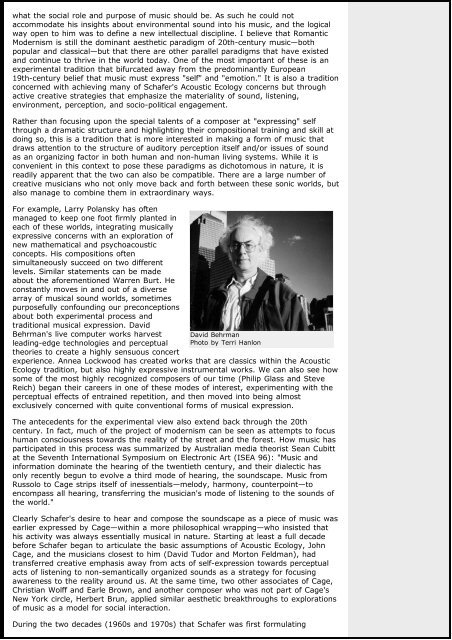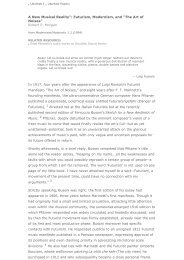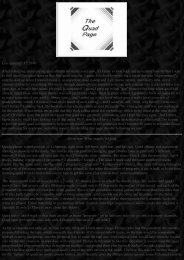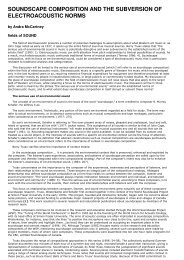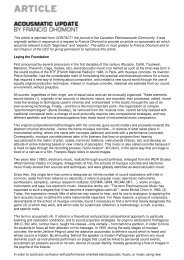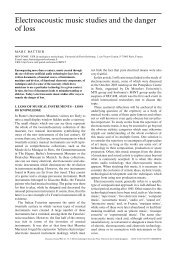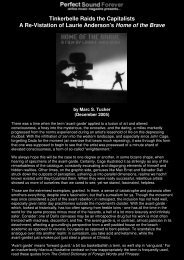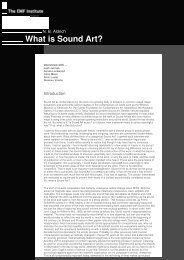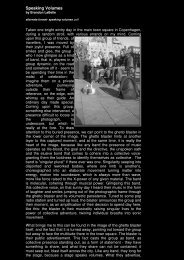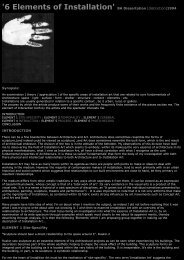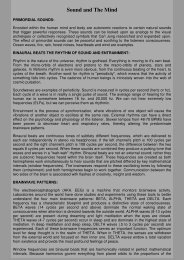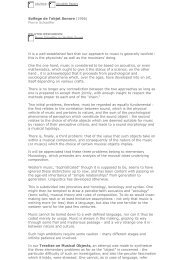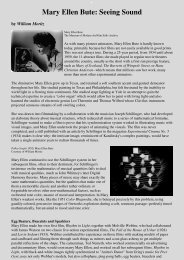Dunn-2008-Acoustic Ecology and the Experimental Music Tradition ...
Dunn-2008-Acoustic Ecology and the Experimental Music Tradition ...
Dunn-2008-Acoustic Ecology and the Experimental Music Tradition ...
- No tags were found...
You also want an ePaper? Increase the reach of your titles
YUMPU automatically turns print PDFs into web optimized ePapers that Google loves.
what <strong>the</strong> social role <strong>and</strong> purpose of music should be. As such he could notaccommodate his insights about environmental sound into his music, <strong>and</strong> <strong>the</strong> logicalway open to him was to define a new intellectual discipline. I believe that RomanticModernism is still <strong>the</strong> dominant aes<strong>the</strong>tic paradigm of 20th-century music—bothpopular <strong>and</strong> classical—but that <strong>the</strong>re are o<strong>the</strong>r parallel paradigms that have existed<strong>and</strong> continue to thrive in <strong>the</strong> world today. One of <strong>the</strong> most important of <strong>the</strong>se is anexperimental tradition that bifurcated away from <strong>the</strong> predominantly European19th-century belief that music must express "self" <strong>and</strong> "emotion." It is also a traditionconcerned with achieving many of Schafer's <strong>Acoustic</strong> <strong>Ecology</strong> concerns but throughactive creative strategies that emphasize <strong>the</strong> materiality of sound, listening,environment, perception, <strong>and</strong> socio-political engagement.Ra<strong>the</strong>r than focusing upon <strong>the</strong> special talents of a composer at "expressing" selfthrough a dramatic structure <strong>and</strong> highlighting <strong>the</strong>ir compositional training <strong>and</strong> skill atdoing so, this is a tradition that is more interested in making a form of music thatdraws attention to <strong>the</strong> structure of auditory perception itself <strong>and</strong>/or issues of soundas an organizing factor in both human <strong>and</strong> non-human living systems. While it isconvenient in this context to pose <strong>the</strong>se paradigms as dichotomous in nature, it isreadily apparent that <strong>the</strong> two can also be compatible. There are a large number ofcreative musicians who not only move back <strong>and</strong> forth between <strong>the</strong>se sonic worlds, butalso manage to combine <strong>the</strong>m in extraordinary ways.For example, Larry Polansky has oftenmanaged to keep one foot firmly planted ineach of <strong>the</strong>se worlds, integrating musicallyexpressive concerns with an exploration ofnew ma<strong>the</strong>matical <strong>and</strong> psychoacousticconcepts. His compositions oftensimultaneously succeed on two differentlevels. Similar statements can be madeabout <strong>the</strong> aforementioned Warren Burt. Heconstantly moves in <strong>and</strong> out of a diversearray of musical sound worlds, sometimespurposefully confounding our preconceptionsabout both experimental process <strong>and</strong>traditional musical expression. DavidBehrman's live computer works harvestleading-edge technologies <strong>and</strong> perceptual<strong>the</strong>ories to create a highly sensuous concertDavid BehrmanPhoto by Terri Hanlonexperience. Annea Lockwood has created works that are classics within <strong>the</strong> <strong>Acoustic</strong><strong>Ecology</strong> tradition, but also highly expressive instrumental works. We can also see howsome of <strong>the</strong> most highly recognized composers of our time (Philip Glass <strong>and</strong> SteveReich) began <strong>the</strong>ir careers in one of <strong>the</strong>se modes of interest, experimenting with <strong>the</strong>perceptual effects of entrained repetition, <strong>and</strong> <strong>the</strong>n moved into being almostexclusively concerned with quite conventional forms of musical expression.The antecedents for <strong>the</strong> experimental view also extend back through <strong>the</strong> 20thcentury. In fact, much of <strong>the</strong> project of modernism can be seen as attempts to focushuman consciousness towards <strong>the</strong> reality of <strong>the</strong> street <strong>and</strong> <strong>the</strong> forest. How music hasparticipated in this process was summarized by Australian media <strong>the</strong>orist Sean Cubittat <strong>the</strong> Seventh International Symposium on Electronic Art (ISEA 96): "<strong>Music</strong> <strong>and</strong>information dominate <strong>the</strong> hearing of <strong>the</strong> twentieth century, <strong>and</strong> <strong>the</strong>ir dialectic hasonly recently begun to evolve a third mode of hearing, <strong>the</strong> soundscape. <strong>Music</strong> fromRussolo to Cage strips itself of inessentials—melody, harmony, counterpoint—toencompass all hearing, transferring <strong>the</strong> musician's mode of listening to <strong>the</strong> sounds of<strong>the</strong> world."Clearly Schafer's desire to hear <strong>and</strong> compose <strong>the</strong> soundscape as a piece of music wasearlier expressed by Cage—within a more philosophical wrapping—who insisted thathis activity was always essentially musical in nature. Starting at least a full decadebefore Schafer began to articulate <strong>the</strong> basic assumptions of <strong>Acoustic</strong> <strong>Ecology</strong>, JohnCage, <strong>and</strong> <strong>the</strong> musicians closest to him (David Tudor <strong>and</strong> Morton Feldman), hadtransferred creative emphasis away from acts of self-expression towards perceptualacts of listening to non-semantically organized sounds as a strategy for focusingawareness to <strong>the</strong> reality around us. At <strong>the</strong> same time, two o<strong>the</strong>r associates of Cage,Christian Wolff <strong>and</strong> Earle Brown, <strong>and</strong> ano<strong>the</strong>r composer who was not part of Cage'sNew York circle, Herbert Brun, applied similar aes<strong>the</strong>tic breakthroughs to explorationsof music as a model for social interaction.During <strong>the</strong> two decades (1960s <strong>and</strong> 1970s) that Schafer was first formulating


